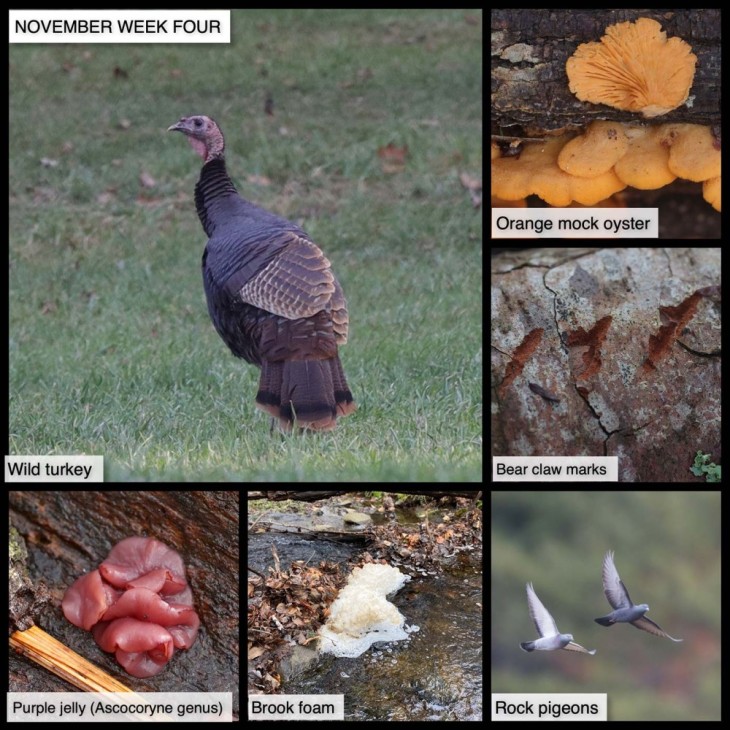This Week in the Woods, wild turkeys are out in agricultural fields, gleaning seeds left from harvests and, no doubt, the insects and other small prey they find there, too. Given how prevalent they are on the landscape now, it’s easy to forget that for most of the 20th century, turkeys were missing from much of New England. In Vermont, for example, the birds were wiped out (in great part from loss of forested habitat) by the late 19th century and were reintroduced in 1969. The return of the birds may also have played a part in the recovery of bobcat populations in New Hampshire and other parts of the Northeast. Here’s a short photo essay depicting the life of wild turkeys by photographer Bob Michelson, from the Autumn 2020 issue of Northern Woodlands.
Here are some other nature sights (clockwise):
The unseasonably warm weather has meant an extension of autumn mushroom season, and we’re still seeing fresh-looking specimens of orange mock oyster mushrooms out on the trails. Take a whiff if you dare: they can be really stinky. They’re also distinctive for the tomentose (very fuzzy) surface of their caps. Here’s a link to a profile from Michael Kuo’s Mushroom Expert blog.
Another result of a warm autumn is that there’s still plenty of bear activity in the woods. We found these claw marks on a log. As Susan Morse notes in this Tracking Tips column from the Summer 2010 issue of Northern Woodlands, the angle of claw marks on a tree may indicate whether you’re looking at marks from the front or back paws. Hind claw marks tend to be straight up and down, while front claw marks may be angled as much as 45 degrees.
Rock pigeons inhabit most of the U.S., as well as southern Canada, and are well adapted to living around humans. It’s easy to dismiss them as “junk birds,” but as with so much of nature, the more you pay attention, the more you recognize their beauty and complex life history. We’ve been seeing an abundance of them recently, especially by rivers and over farm fields. As this photo shows, their plumage varies, from light shades to rich purple. Here’s a profile from the Cornell Lab’s All About Birds site, which includes information on the birds’ fascinating trick of feeding their chicks a milk-like substance, secreted from their crops.
Assistant Editor Meghan McCarthy McPhaul found this clump of brook foam floating in a forest stream. Forest foam may look like pollution, but worry not. As explained in this post from NHPR’s Sam Evans Brown, this is a natural phenomenon that results from organic matter getting caught up in water turbulence (for example, when streams swell and speed up during a downpour). As the post explains, what you’re seeing is the Marangoni effect in action: the mixing of the fine debris in the water reduces surface tension, which stabilizes bubbles.
Finally, we’ve found a couple specimens of rose-colored jellies this week. These are fungi in the Ascocoryne genus, and as noted by Timothy Baroni in his guide, Mushrooms of the United States and Eastern Canada, you typically find these (as we have) on “well-decayed or at least barkless hardwood logs and stumps,” although he notes they also sometimes appear on downed conifers.
Our thanks to The Bailey Charitable Foundation and the Frank and Brinna Sands Foundation for helping to support this series.
In this difficult period, many of us find joy in observing local nature. This series, launched in April 2020, shares nature photographs taken in the past seven days, or in the same week in 2020, most within 15 miles of the Northern Woodlands office in Lyme, New Hampshire. We hope you enjoy using this grid as a prompt for your own explorations.
What are you seeing in the woods this week? Share your images with us on Facebook, or submit a special photo for possible inclusion in our monthly online Reader Photo Gallery.


